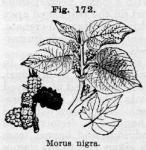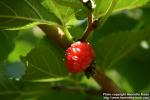Morus Rubra.—Red Mulberry.

 Preparation: Syrup of Mulberries
Preparation: Syrup of Mulberries
The fruit of Morus rubra, Linné.
Nat. Ord.—Urticaceae.
COMMON NAME: Red mulberry.
Botanical Source.—Morus rubra, or the Red mulberry, is but a shrub in the northern and New England states, 15 to 20 feet high, but in the middle and western states it attains an elevation of 50 to 60 feet, with a diameter of 2 feet, and covered with a grayish, furrowed, much-broken bark. The leaves are alternate, rounded or subcordate at base, acuminate, equally serrate, either ovate or 3-lobed, rough above, pubescent beneath, thick, dark-green, 4 to 6 inches long, and about two-thirds as wide. The flowers are small, monoecious, rarely dioecious; sterile ones in loose spikes; calyx 4-parted; fertile ones in dense spikes; styles 2, filiform, stigmatic down the inside. The ovary is 2-celled, one of the cells smaller and disappearing. Achenium ovate, compressed, inclosed within the succulent, berry-like calyx. Fertile spikes cylindric, constituting a dark-red, thickened, oblong and juicy, compound berry or fruit. The sterile spikes are rather slender (W.—G.).
History.—The red mulberry is indigenous to the United States, growing in rich woods, flowering in May, and ripening its fruit in July. The wood of the tree is fine grained, strong, and durable. The fruit is oblong-oval, of a dark-red color, and is compounded of a great number of small berries, which are very juicy, inodorous, and of an agreeable sweetish and acidulous taste; in appearance it very much resembles the fruit of the blackberry. This species is fully equal in value to the Morus nigra, Linné, of Europe (figured in Bentley and Trimen, Med. Plants, 229), the juice of which was official in the British Pharmacopoeia, 1885, under the title Mori Succus.
 The Morus nigra, Linné, possesses similar properties. It is probably a native of the Levant, though cultivated in Europe, and to some extent in the United States. This species, and that following, is a tree of about 30 feet in height, and has a purplish, black, berry-like fruit. Its leaves furnish food for silk-worms. The Morus alba, Linné, a native of China, with white fruit which is more saccharine and less pleasant than the preceding species, is one of the trees upon the foliage of which the silk-worm feeds. This species is naturalized in this country.
The Morus nigra, Linné, possesses similar properties. It is probably a native of the Levant, though cultivated in Europe, and to some extent in the United States. This species, and that following, is a tree of about 30 feet in height, and has a purplish, black, berry-like fruit. Its leaves furnish food for silk-worms. The Morus alba, Linné, a native of China, with white fruit which is more saccharine and less pleasant than the preceding species, is one of the trees upon the foliage of which the silk-worm feeds. This species is naturalized in this country.
Chemical Composition.—Mulberries are said to consist of bitartrate of potassium, pectin, sugar, woody fiber, coloring matter and water. They contain rather more grape-sugar than the ordinary berries, such as strawberries, blackberries, currants, etc., being exceeded only by the cherry and grape. Fresenius found mulberries of the following percentage composition: sugar, 9.19; malic acid with a little tartaric, 1.86; albuminous matter, 0.361; gum, pectin, and fatty matter, 2.31; woody fiber, 0.91; ash, 0.66; water, 84.71. Wright and Patterson (Pharm. Jour. Trans., Vol. VIII, 1878, p. 540) found the solid matter in the juice of the unripe berries to amount to 70.16 Gm. to the liter. A large proportion (26.83 Gm.) of this was citric acid, and a smaller quantity (7.82 Gm.) was malic acid. G. Goldsmith (Amer. Jour. Pharm., 1882, p. 456) observed succinic acid in the form of its calcium salt (C4H4OCa) in an exudation from the bark of Morus alba. It is the mulberry acid of Klaproth.
Action, Medical Uses, and Dosage.—Mulberries possess very slightly nutritive qualities; they are refrigerant and laxative, and their juice forms a pleasant and grateful drink for patients suffering under febrile diseases, as it checks the thirst, relieves febrile heat, and when taken freely, gently relaxes the bowels. The juice, formed into a syrup and added to water, answers the same purpose, and forms a pleasant adjunct to gargles in quinsy. If the berries are eaten to excess they are apt to induce diarrhoea. The bark of the tree is reputed purgative and vermifuge, having expelled tapeworm.

